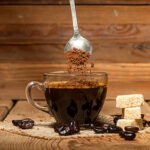Espresso, the pinnacle of coffee craft, is an art as much as it is a science. At its core, one of the fundamental secrets to a sublime espresso lies in the balance of coffee-to-water ratio. For coffee enthusiasts and baristas, nailing this ratio is non-negotiable for producing that coveted golden shot. But how do you quantify perfection in your espresso brewing? And more importantly, how many grams of coffee does it take to get there? In this comprehensive guide, we’ll dissect the intricacies of measuring the precise amount of coffee for the perfect shot of espresso, and how to customize it to your tastes.

Understanding the Basics of Coffee-to-Water Ratio
In the realm of espresso, the coffee-to-water ratio (or C:w ratio) determines the strength, body, and flavor profile of your shot. Simply put, it’s the quantity of coffee in relation to water used in the brewing process. Getting this ratio right ensures your espresso isn’t too weak, which can result in a watery, insipid taste, or too strong, leading to an over-extracted, bitter outcome.
The Role of Grind Size in Espresso Making
Grind size is the unsung hero that works hand-in-hand with the C:w ratio. For espresso, fine grinds are your best bet as the method of extraction is much quicker, typically 20-30 seconds. This fine grind is essential in providing the increased surface area needed to extract the coffee’s goodness in such a short time, which is key to achieving that rich, concentrated flavor.
Best Espresso Maker

How Many Grams of Coffee for Espresso?
The golden question: what’s the magic number of grams of coffee to use for a single or double shot of espresso? While this may vary for each person’s preferences, there are typically agreed-upon ranges to aim for.
Ideal Coffee-to-Water Ratio for a Perfect Shot
For a single 30ml shot, aim for a coffee-to-water ratio of around 1:2, which translates to around 16-18 grams of dry coffee. A double shot, also known as a doppio, which yields 60ml, often requires between 32 and 36 grams of coffee at the same ratio.
Influencing Factors on Your Coffee Quantity
Beans are not created equal, and the type and roast can significantly influence the required amount of ground coffee. Lighter roasts, for example, are denser and might require a higher dose to achieve the same strength as a darker, more loosely packed roast.
Customizing Your Ratio to Taste
The beauty of making espresso at home lies in the ability to tailor each shot to your individual preference. If you prefer a stronger taste, you may up the dose slightly; if a milder flavor is more your speed, then a little less coffee might be in order.
Classic Espresso Recipe for Beginners
Now that we’ve covered the essentials of espresso and the importance of the coffee-to-water ratio, here’s a simple recipe to get you started on making the perfect shot at home:
Ingredients:
- 18 grams of freshly ground coffee (fine espresso grind)
- 30ml of filtered water
Equipment:
- Espresso machine
- Coffee grinder
- Tamper
- Espresso cup
Instructions:
- Preheat your espresso machine according to the manufacturer’s instructions to ensure it’s at the optimal temperature for extraction.
- Grind your coffee beans to a fine espresso consistency. It’s crucial to grind your beans right before brewing to maximize freshness and flavor.
- Measure 18 grams of the ground coffee and place it into the espresso machine’s portafilter. This quantity is ideal for making a single shot of espresso.
- Tamp the grounds evenly and firmly with the tamper. This step is key to ensure the water will flow through the coffee grounds evenly, extracting maximum flavor.
- Lock the portafilter in place in the espresso machine and start the extraction. Aim for a brew time of 25-30 seconds. Adjusting the grind size can help achieve this timing if it’s off.
- Catch the espresso in a pre-warmed cup as it dispenses. A proper extraction will be crowned with a crema, the golden creamy layer on top.
- Taste and adjust if necessary. If your espresso is too bitter, try a slightly coarser grind or a bit less coffee. If it’s too sour, try a finer grind or a tad more coffee.
Tips:
- Always use filtered water for a clearer taste.
- Experiment with different coffee beans to find your preferred flavor profile.
- Cleaning your equipment after each use will prevent old coffee oils from impacting the taste of your espresso.
Indulge in the rich flavors and enjoy the process of perfecting your espresso-making skills from the comfort of your home.

Practical Applications: Measuring and Preparing Coffee for Espresso
The method of measuring out your coffee for espresso is just as crucial as the amount itself.
Using a Scale for Precision
Investing in a quality coffee scale is a game-changer. Not only does it provide precision, but it also ensures consistency in every brew, allowing you to fine-tune your recipe with confidence.
Step-by-Step Guide to Espresso Coffee
- Calibration: Tare your portafilter on the scale and add the precise amount of ground coffee.
- Distribution: Ensure you have even distribution of coffee in the portafilter, using a leveler or your fingers, making sure to distribute the coffee evenly without pressing down.
- Tamping: A firm, level tamp is crucial for an even extraction. Aim for 30 pounds of pressure, which is about the weight of a bag of sugar.
- Extraction: Timing is everything. A shot that pours too fast might be under-extracted, while a slow pour could mean over-extraction.
Troubleshooting Common Mistakes
- If your shot is sour, adjust your grind finer.
- If it’s bitter, go coarser.
- If the shot is weak, use more coffee.
- If it’s too strong, use less.
Each tweak affects the extraction process and, therefore, the end result.
Enhancing the Experience with Specialty Beans and Tools
To truly elevate your espresso game, curate a selection of high-quality coffee beans, both blends and single-origin, that suit your preferred taste profile. Additionally, tools such as a quality grinder can ensure the perfect grind size, while a distributor and tamper set can aid in the quest for consistency.
Conclusion: Tailoring Your Espresso Journey
Crafting the perfect shot of espresso is not a destination, but a delicious odyssey of refining techniques and taste. Always start with the recommended coffee-to-water ratio and adjust to your liking. Remember, every tweak brings you closer to creating that perfect, personal cup of espresso. Enjoy the exploration and cheers to many satisfying sips!







